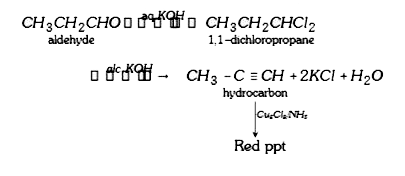A dihalogen dervative 'X' of a hydrocarbon with three carbon atoms reacts with alcoholic KOH and produces another hydrocarbon which forms a red precipitate with ammoniacal Cu2Cl2.'X' gives an aldehyde on reaction with aqueous KOH. The compound 'X' is :
1, 3– dichloropropane
1, 2– dichloropropane
2, 2– dichloropropane
1, 1– dichloropropane
The correct Answer is:D
The reaction sequence is as follows

Topper's Solved these Questions
- BOOK - ERRORLESSCHAPTER - HELOALKANES AND HALOARENESEXERCISE - NCERT BASED QUESTIONS (Haloarenes)40videos
HELOALKANES AND HALOARENES
- BOOK - ERRORLESSCHAPTER - HELOALKANES AND HALOARENESEXERCISE - NCERT BASED QUESTIONS (Uses of Halogen Containing Compounds)11videos
HELOALKANES AND HALOARENES
- BOOK - ERRORLESSCHAPTER - HELOALKANES AND HALOARENESEXERCISE - NCERT BASED QUESTIONS (Properties of Alkyl Halides)56videos
HELOALKANES AND HALOARENES
- BOOK - ERRORLESSCHAPTER - GENERAL PRINCIPLES & PROCESSES OF ISOLATION OF ELEMENTSEXERCISE - ASSERTION & REASON8videos
GENERAL PRINCIPLES & PROCESSES OF ISOLATION OF ELEMENTS
- BOOK - ERRORLESSCHAPTER - ORGANIC COMPOUNDS CONTAINING NITROGENEXERCISE - Assertion and Reason15videos
ORGANIC COMPOUNDS CONTAINING NITROGEN
Similar Questions
A dihalogen derivative (A) of a hydrocarbon having two carbon atoms reacts with alcoholic potash and forms another hydrocarbon which gives a red precipitate with ammoniacal cuprous chloride. Compound A gives an aldehyde when treated with aqueous KOH. Write down the name and formula for the organic compound.
View SolutionA hydrocarbon (A) on chlorinatio gives (B) ,which on reacting with alcoholic KOH changes into another hydrocarbon (C ) .The latter decolorizes Bayer's reagent and on ozonolysis forms formaldehyde only (A) is:
View Solution
Knowledge Check
- Question 1 - Select One
A dihalogen derivative 'X' of hydrocarbon with three carbon atom reacts with alcoholic KOH and produces another hydrocarbon which forms a red precipitate with ammoniacal Cu2Cl2. 'X' gives an aldehyde on reaction with aqueous KOH. The compound X is
A1, 3-Dichloro propaneB1, 2-DichloropropaneC2, 2-DichloropropaneD1, 1-Dichloropropane - Question 2 - Select One
A gas which reacts with aqueous KMnO4 solution but does not give precipitates with ammonical Cu2Cl2 solution is
AEthyleneBMethaneCEthaneDAcetylene - Question 3 - Select One
2-Chloro-2-methylpropane on reaction with aqueous KOH gives X as the major product. X is
A2-ButeneB2-MethylpropeneC1-ButeneD2-Methyl-2-propanol
The unsaturated hydrocarbon obtained by the reaction of a dihalogen derivative with alcoholic potash gives a red precipitate with ammoniacal cuprous chloride. The dihalogen derivative gives propanal on heating with aqueous potash. The dihalogen derivative is:
View SolutionThe unsaturated hydrocarbon obtained by the reaction of a dihalogen derivative with alcoholic potash gives a red precipitate with ammoniacal cuprous chloride. The dihalogen derivative gives propanal on heating with aqueous potash. The dihalogen derivative is:
View SolutionThe unsaturated hydrocarbon obtained by the reaction of a dihalogen derivative with alcoholic potash gives a red precipitate with ammonical cuprous chloride. The dihalogen derivative gives propanal on heating with aqueous potash. The dihalogen derivative is
View SolutionA dihalogen derivative (A) with three C-atoms gives a hydrocarbon (B) on reacting with alc KOH. (B) gives a white precipitate with Tollen’s reagent. (A) on heating with aqueous KOH gives a ketone. Compound (A) is:
View SolutionA dihalogen derivative (A) with three C-atoms gives a hydrocarbon (B) on reacting with alco. KOH. (B) gives a white precipitate with Tollen's reagent. (A) on heating with aqueous KOH gives a ketone. Compound (A) is
View Solution
